| Content | RÉSUMÉ DES FONCTIONNALITÉS
Images de 24, 32, 40 et 48 canaux
Options de canal mono / stéréo A, B, C, D
Mélanges principaux LR et M
8 groupes audio avec panoramique et routage vers LR et M
10 auxiliaires dont un envoi stéréo dédié avec commandes de niveau et de panoramique
2 canaux stéréo multifonctions chacun avec entrées micro et ligne stéréo
2 doubles stéréos supplémentaires fournissent 4 retours stéréo additionnés ou indépendants
Matrice 12 × 4 complète
Double fonctionnalité appropriée pour FoH, mixage de moniteur ou les deux
Enregistrement capable avec des sorties directes de canal
M peut être utilisé pour le mixage centre / sous, la somme mono LR ou le coin d'ingénierie
Entrées externes matricielles avec trims de niveau et capacité d'entrée commune
Les entrées micro du canal stéréo peuvent se croiser dans la matrice pour une alimentation d'ambiance
EQ réactif 4 bandes, 2 balayages
Filtres passe-haut de canal 100Hz
Alimentation fantôme individuelle et commutation de polarité
Compteur intégré avec 11 VU-mètres à bobine mobile éclairés par LED
Canal LED grand angle et compteurs principaux
Compteurs de contrôle stéréo dédiés
Commutation auxiliaire par canal pré / post fader pour une flexibilité totale
Commutateurs pré / post-EQ du panneau avant pour les préférences de l'utilisateur
Coupe le son de tous les faders masters
Faders à double rail de qualité supérieure de 100 mm
Talkback assignable à toutes les sorties, comprend un mode de verrouillage de commutateur de conversation
Oscillateur 1 kHz / générateur de bruit rose avec sortie externe
Surveillance 2 pistes et relecture sur LR
3 prises casque / écouteurs et sorties moniteur locales
Sorties XLR symétrisées électroniquement avec capacité d'entraînement + 26 dBu
Gamme de préamplis 74 dB avec capacité d'entrée +34 dBu pour micro ou ligne
Conception d'ampli micro à très faible bruit
Combiner intégré pour une alimentation de secours redondante
Assemblage de cartes de circuits individuelles avec des pots écroués
Option de liaison d'entrée / sortie de console Sys-Link V2
Douilles de lampe XLR 4 broches - Lampe LED Allen & Heath disponible.
Options de canal mono / stéréo:
A = tous les canaux mono
B = 4 stéréos à droite des masters
C = 4 stéréos à l'extrême droite
D = 8 stéréos à l'extrême droite | Avid S1 eight-fader EUCON control surface
The Avid S1 is an eight-fader EUCON control surface with unparalleled speed, rich visual feedback, and software integration of Avid's high-end consoles in a slimline surface that's an easy fit for any space or budget. Avid S1 gives you deep hands-on control of your favorite audio and video software and, together with the free Pro Tools | Control app for iPad (iPad not included), provides great ergonomic efficiency, easy touch workflows, and S6-style metering and processing views, so you can navigate large sessions quickly, mix more intuitively, and turn around better sounding mixes fast.
Mix big on a smaller scale
While Avid S1 fits easily between your display and keyboard, it packs a lot of mixing power into its small surface. From motorized faders and knobs that respond to your touch, to fast-access touchscreen workflows and Soft Keys that enable you to perform complex tasks with a single press, S1 provides the speed and versatility to accelerate any music, audio post, or video project.
Get unmatched software integration
S1 is powered by EUCON, Avid’s high-speed Ethernet control protocol that delivers deep hardware/software integration, giving you full touch and tactile access to a host of Avid and third-party software functions and controls. You can even switch between multiple applications—and workstations—at the touch of a button, providing the most fluid editing and mixing experience.
Specifications:
- Faders: Eight motorized, touch-sensitive, 100 mm long-throw faders
- Knobs: Eight push-top, touch-sensitive rotary encoders
- Additional controls: Assorted hardware buttons/keys for various functions and mode selections, including Mute, Solo, Record-enable, Bank, Nudge, and more
- Software interface: Supports the free Pro Tools | Control app running on iPad (iPad not included), providing touchscreen control, project navigation, macro triggers, and more
- Displays: Eight high-resolution OLED displays, plus multiple status LEDs and multicolor track buttons; channel metering, monitoring, processing, track status, automation modes, and other views provided by Pro Tools | Control on iPad
- Height (front, rear): 1.2 inches, 3.8 inches (29 mm, 97 mm)
- Width: 12.3 inches (312 mm)
- Depth: 14.9 inches (377 mm)
| Heritage Audio's MCM-8 MK2 is an 8-slot 500 Series chassis with an integrated 10-channel summing mixer. The top-of-the-line MCM-8 MK2 features On Slot Technology that leverages next-generation power electronics to handle power supply on a per slot basis. Each slot has its own power supply linear regulation stages, isolating each module from the rest. Your modules simply share the metal enclosure. Each slot even has test LEDs for checking correct power operation. Dual-concentric potentiometers handle Volume and Pan for each slot, with pan pots being center detented for precise center positioning. Each channel is equipped with an On switch to assign it to the mix bus. MK2 improvements include a lower noise floor and the addition of a bypass switch for each slot that still lets you use the summing mixer functions. Heritage Audio has earned the respect of Sweetwater engineers, and the MCM-8 MK2 lives up to that sterling reputation.
Superb build and feature set
From its RAF blue-gray enclosure to the solid tactile feedback from its knobs and switches, the Heritage Audio MCM-8 MK2 unabashedly rocks vintage British Class A vibe. And just like the classic gear that inspires all Heritage Audio equipment, the MCM-8 MK2 boasts superb build quality and a very smart feature set. There's an additional stereo input on the back panel, which allows several MCM-8 MK2 units to be daisy-chained — or signals not needing further 500 Series processing to be mixed together. The central section sports analog VU meters and a Stereo Master fader. Gold-plated XLRs and DSUB25s handle the I/O.
Smart technology, superior sound
Thanks to Heritage Audio's On Slot Technology (OST), the MCM-8 MK2's power capability is a maximum of 400mA per rail, per slot — with an overall of 1.4A (1.6A non-continuous) per rail, whichever is reached first. Total available phantom power is 140mA. The mix bus has a passive voltage summing topology, similar to that found in Rupert Neve's 80 Series consoles of the 1970s. The gain loss is restored by the same Class A, 2n3055 driven, transformer-based output stage used in the Heritage Audio's modern-day version of the classic 1073. If you're not into specs, what this all means is that the MCM-8 MK2 is built right to give you many years of authoritative sonic performance and trouble-free use in your studio or on the road.
Heritage Audio MCM-8 MK2 Features:
- 8-slot 500 Series chassis with integrated 10-channel summing mixer
- NEW lower noise floor
- NEW bypass switch for each slot that leaves summing mixer functions enabled
- Mix bus with vintage Neve-style passive voltage summing topology
- Additional stereo input on the back panel allows several MCM-8s to be daisy-chained
- Central section sports analog VU meters and a Stereo Master fader
- Handles power supply on a per slots basis, isolating each module from the rest
- Gold-plated XLRs and DSUB25s handle your I/O
- 140mA total available phantom power
- Class A transformer-based output stage
- Solid build quality for many years of trouble-free use
| Working inside the box? Sweetwater would like to recommend a summing mixer that will seriously up your game: the Rupert Neve Designs 5059 Satellite Shelford Edition. If you record and mix entirely within your DAW, you’re hampered by the inability to leverage the sonic advantages of high-quality analog outboard gear. Enter the 5059 Satellite. The 5059 gives you 16 channels — each with individual level and pan, plus insert and bus-2 send buttons. You get two stereo buses with RND’s proprietary Silk Texture controls, giving you effortless integration with outboard equipment, total control for two separate stem mixes, and the facility to dial in harmonic enhancement in two distinct flavors.
It’s a Neve
In serious audio circles, Rupert Neve needs no introduction. Large-format Neve consoles from the 1970s are considered by many to be the pinnacle of analog mixer design. Boasting the same design heritage and sonic perfectionism that went into the boards used to record countless hit records, the 5059 Satellite Summing Mixer graces your tracks with legendary Rupert Neve warmth, punch, and presence. With 16 channels of Rupert Neve designed Class A alchemy and flexible tonal and routing options, the Rupert Neve Designs 5059 Satellite Summing Mixer will take your DAW-based studio’s sound to a whole new level.
Dial in the Silk
The Rupert Neve Designs’ 5059 Satellite Summing Mixer’s continuously variable Texture controls with Silk and Silk+ modes let you fine-tune the harmonic ratio and tonality of each of 5059’s stereo buses. The Silk mode adds sparkle to your tracks by introducing alluringly airy transformer saturation in the high frequencies. Silk+ mode accentuates saturation in the low frequencies, adding density and thickness to the source — particularly desirable when you’ve got a dry, lackluster mix. Distinctly different sounding from equalization, Texture saturates the output transformers, adding sweet, musical even-order harmonics to your source material for authoritative, radio-ready mixes that blast right out of the speakers.
Flexibility: it’s a beautiful thing
The dual stereo outputs of the Rupert Neve Designs 5059 Satellite Summing Mixer are perfect for creating stem mixes, which you can enhance using the 5059’s Silk/Texture controls, then process through bus compressors or other devices via the inserts, finally feeding into the inputs of another mixer or your interface. You can send any input to stereo bus 1 or 2, and create two very different-sounding mixes from the same 16 channels. These are just some examples of the amazing flexibility you’ll enjoy when integrating the 5059 into your recording rig. Smartly attired in classic Shelford livery, the Rupert Neve Designs 5059 Satellite Summing Mixer is housed in a rugged, fan-cooled 2U steel chassis for dependable, no-compromise professional performance year after year, in the studio or on the road.
The legend continues
Rupert Neve’s 80-series consoles had a huge, punchy, and authoritative sound that defined the sound of ’70s rock. From London to New York to Los Angeles and beyond, top studios were installing Neve boards as fast as they could. By 1977, with the introduction of the NECAM automation system, 80-series boards were the main component of the success formula for any recording studio with world-class aspirations. Mr. Neve’s current company, Rupert Neve Designs, continues to advance the state of the art with cutting-edge products that sound incredible and intelligently address the challenges of the digital age. With your Rupert Neve Designs 5059 Satellite Shelford Edition from Sweetwater, the legend continues.
Rupert Neve Designs 5059 Satellite Summing Mixer Shelford Edition Features:
- Classic Neve: Class A, all transformer-balanced, and awesome-sounding
- Zero crossover distortion and unmatched purity
- Custom transformers provide galvanic isolation and serve up "larger than life" sound
- Sets a standard for rackmountable summing mixers
- 16 inputs/channels (with level controls, pans, and inserts); 2 stereo buses
- Send any input to stereo bus 1 or 2, each with variable Silk/Silk+ Texture
- Dual Stereo Outputs let you split the input channels into 2 stems for further processing and mixing
- Stereo buss 1 and 2 each has its own XLR outs
- DB-25 line input, insert send/return connectors
- Rugged 2U fan-cooled chassis, clad in classic Shelford livery
| The Dangerous Music 2-BUS+ is a 2U, 16-channel analog summing mixer with both XLR and D-sub inputs. It raises the bar on its legendary 2-BUS predecessor with even lower crosstalk, distortion, and noise-floor performance, along with stunningly precise soundstaging and center focus. Dangerous spent over two years developing three onboard audio processors that, with a simple push of a button and twist of a knob, add tone and color to your stems or across your entire mix directly from the 2-BUS+. The 2-BUS+ is smartly designed, extremely useful, and sounds incredible.
A trio of custom audio processors
In sync with Dangerous Music's doctrine of tonal coloration as a per-project artistic choice, the 2-BUS+ features three separate custom audio processors that selectively add tone and color to your mixes. In parallel processing mode, you can deploy Harmonics, a tuned harmonic distortion generator, and Paralimit, a FET limiter on steroids. At Sweetwater, we've applied both of these across stereo mixes and on pairs of stems. X-Former kicks in a pair of custom transformers with core-saturation control on your stereo mix outs. You can have all three tone processors active concurrently, and you can flip the order of signal flow through distortion and limiting.
Outstanding flexibility
Dangerous Music knows that each engineer — and session — is unique, so they designed the 2-BUS+ for outstanding professional flexibility. They spec'd it with an XLR stereo insert before the outputs for adding a separate compressor or processing chain that you can bypass at the touch of a button for a quick reference comparison. Channels 1/2 and 9/10 can be set to mono to rout; for instance, vocals/bass and kick/snare each to its own mono input. They also gave the 2-BUS+ an output control stepped in 0.5dB increments from -4dB to +6dB, and included XLR connections for both the main and monitor outputs.
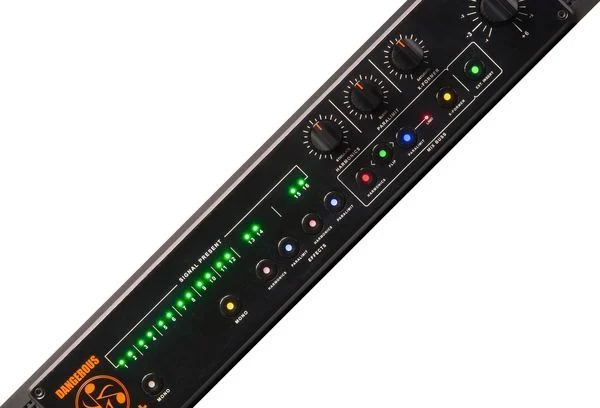
Gang 'em for high channel count
Need a full-on analog "console" summing experience? Gang together multiple 2-BUS+ units via the stereo expansion inputs XLR to create a customized channel count. For the ultimate in tonal flexibility and control, the custom audio processors on each unit apply across the ganged group output. With three units, for instance, you'll have 48 channels of analog summing, with the first two units employing Harmonics (distortion), and Paralimit (limiter) across two separate stereo stems, and the third unit applying X-Former transformer saturation on the master stereo outputs.
What the pros are saying about the 2-BUS+:
- "The Paralimit and X-Former appear to be magic knobs. Special mention goes to the Paralimit because it does that lovely thing of bringing up the general ambience without slamming the track, something I particularly love on drums. Plugged it into my system along with my old 2-BUS and Dangerous MONITOR ST, and wow ... it's fantastic! Bags of air and space around the mix." — Chris Blackwell (drummer/composer)
- "Since the 2-BUS has so much headroom, it's really easy for me to decide that I want the entire vocal submix to be brighter or warmer, or more or less compressed." — Michael James (producer/mix engineer)
- "The Dangerous Music 2-BUS is one of the reasons my studio delivers a killer sound that grants the edge on the competition." — Alberto Rizzo Schettino (engineer)
- "Between SSL, in-the-box, and 2-BUS ... in blind tests ... it was a unanimous decision that the Dangerous mixes beat out everything. The 2-BUS mixes ... were simply cleaner and warmer than the SSL or in-the-box mixing ... I just don't miss my console." — Gina Fant-Saez (mix engineer)
- "With the 2-BUS LT, elements have their own place. You end up with a quicker, bigger mix and retain a more natural, less processed sound." — Phil Greiss (producer/engineer)
- "The Dangerous Music equipment is the centerpiece of my mixing rig. Everything I do goes through a Dangerous MONITOR, 2-BUS, MASTER, and BAX EQ. Everything." — Fab Dupont (mix engineer)
- "I don't understand how the 2-BUS has been in the studio for so long, but hasn't gotten to live shows — the sound is unbelievable." — Horace Ward (FOH engineer)
- "The harmonic and transformer flavors are great options to have and the parallel limiter is a genius idea." — Chris Tabron (producer/mix engineer)
Dangerous Music 2-BUS+ Analog Summing Mixer Features:
- Stunning 16-channel analog summing mixer injects your mixes with exceptional headroom and dimensionality
- 3 analog options (Harmonics, Paralimit, and X-Former) for adding tonal coloration to your mix
- XLR and D-sub input connectivity and flexible routing allow for a customized workflow
- Integrate your outboard gear easily with the switchable stereo analog insert
- Output control is stepped in 0.5dB increments for perfect recallability
- High-quality components ensure audiophile-grade sound
| The Heritage Audio MCM-20.4 is a rackmount analog summing mixer that delivers vintage-quality sonics along with sophisticated routing options to streamline your hybrid studio setup. The MCM-20.4 offers 16 input channels arranged into two subgroups of eight. Each channel features concentric pan and level controls plus a balanced insert and a mute switch. Each group has its own stereo fader and balanced insert point. Both stereo subgroups are passively summed into the master bus, which has its own balanced insert point and VU meters. Makeup gain is provided by a transformer-coupled, 1073-style Class A mic preamplifier with four transformers (two per channel). Four channels of pre/post-fader aux sends are provided: AUX 1 and 2 are mono; AUX 3 is stereo. Insert send points are always signal-present, giving them an alternative use as direct outputs for recording. Rear-panel connections are made via DB-25 connectors; except for the master bus, which has dedicated XLRs.
The best of both worlds
Done up in classic RAF blue-gray livery — complete with concentric pots and Marconi knobs — the Heritage Audio MCM-20.4 gives visual hints as to the sound lurking beneath the bonnet. Flavored by four transformers, that sound is decidedly vintage British, although Heritage has taken pains to improve crosstalk and self-noise specs from those of the vintage designs. The smart-summing topology employed in the company's MCM series mixers delivers impressive headroom and low noise for a 20 channel, vintage-topology mixer. Sweetwater's advice: If you want to smoothly integrate analog gear — and robust, colorful sonics — into your DAW-based workflow, the Heritage Audio MCM-20.4 is a great-sounding, elegant solution.
Heritage Audio MCM-20.4 20-channel, Vintage-topology Rackmount Mixer Features:
- 16 input channels arranged into 2 subgroups of 8
- Each channel features concentric pan and level controls plus a balanced insert and a mute switch
- 2 stereo subgroups are passively summed into the master bus
- Master bus has its own balanced insert point and VU meters
- 4 channels of pre/post-fader aux sends
- Rear-panel connections are made via DB-25 connectors
- Master bus connections via dedicated XLRs
|



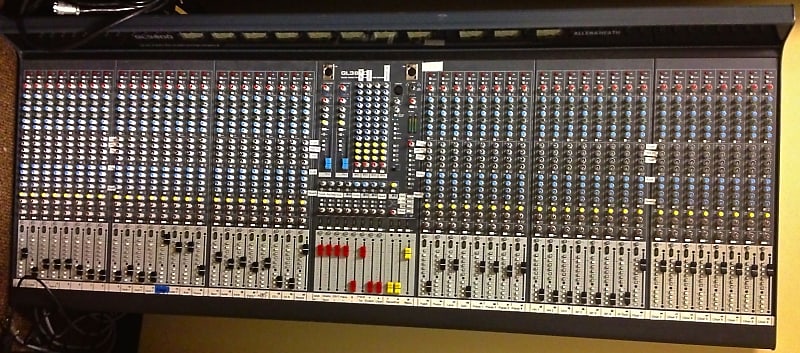
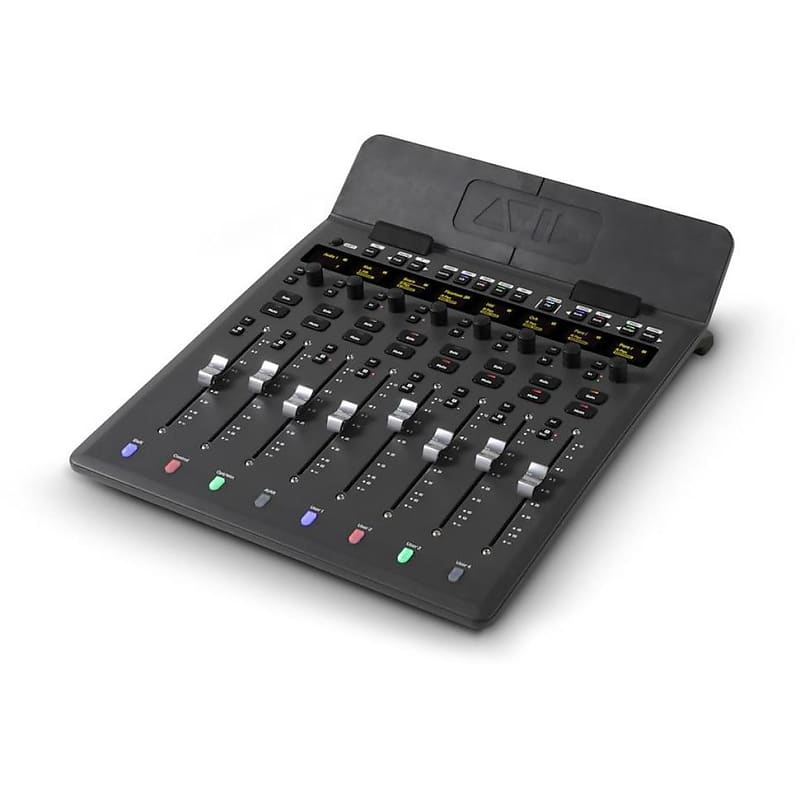


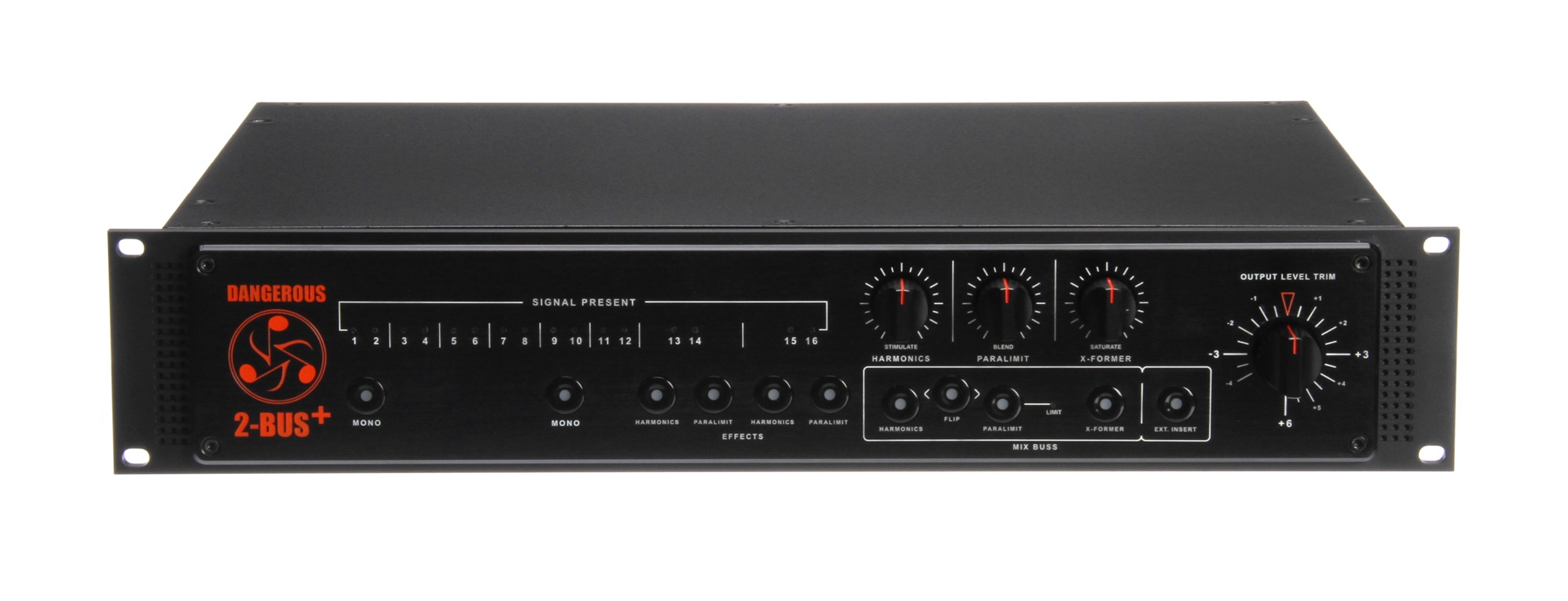
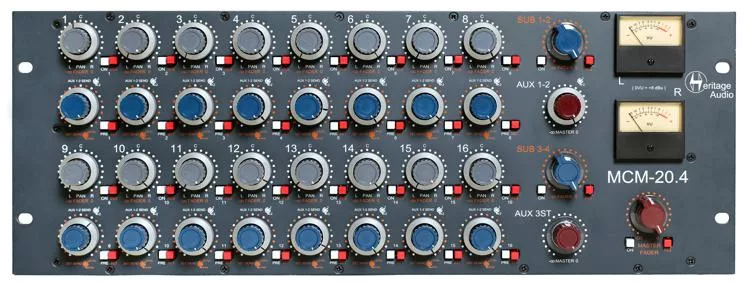
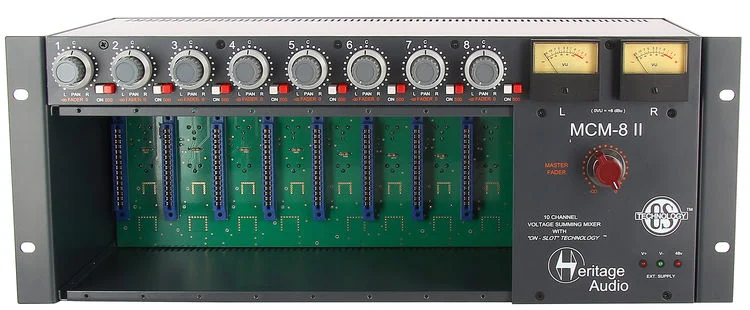

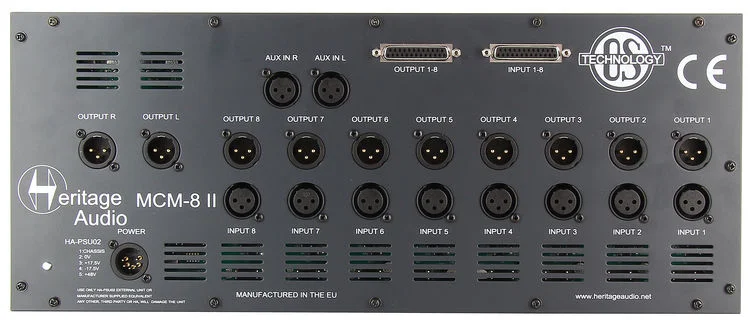


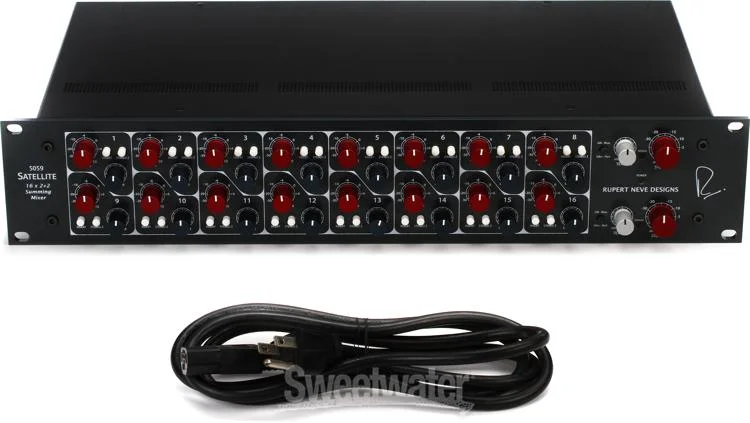

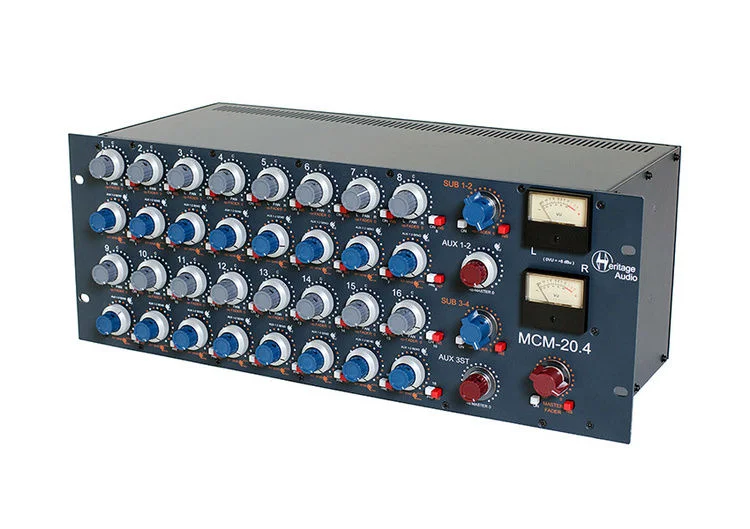
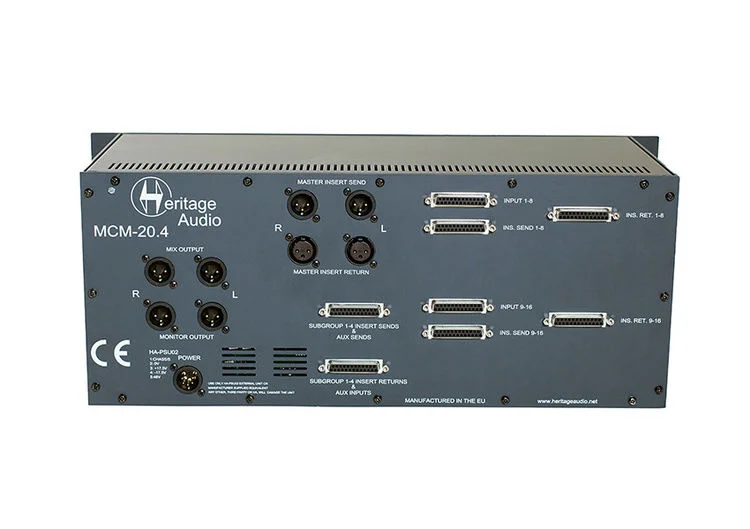




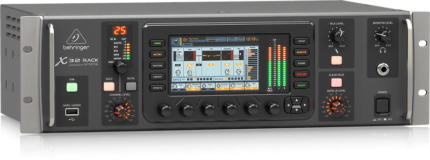





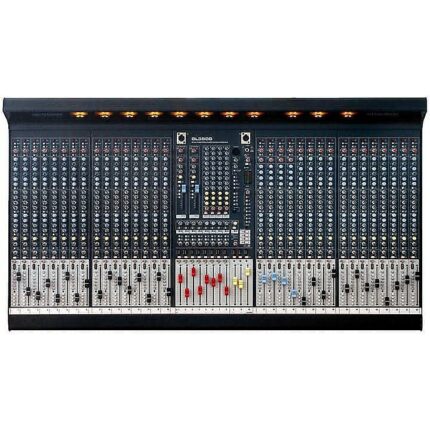
Reviews
There are no reviews yet.